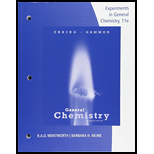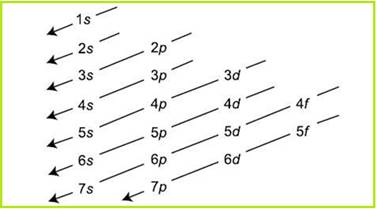
Lab Manual Experiments in General Chemistry
11th Edition
ISBN: 9781305944985
Author: Darrell Ebbing, Steven D. Gammon
Publisher: Cengage Learning
expand_more
expand_more
format_list_bulleted
Concept explainers
Question
Chapter 22, Problem 22.2QP
Interpretation Introduction
Interpretation:
The electronic configuration of Yttrium according to build-up principle has to be written.
Concept Introduction:
The ''build-up'' principle is also known as Aufbau principle. It deals with order of filling of electrons in orbitals. According to this principle, the electrons are filled from lowest energy levels to highest energy levels. It is pictorially represented as,

Expert Solution & Answer
Want to see the full answer?
Check out a sample textbook solution
Students have asked these similar questions
this is an inorganic chemistry question please answer accordindly!!
its just one question with parts till (n) JUST ONE QUESTION with its parts spread out in the form of different images attached 2 IMAGES ATTACHED PLEASE SEE BOTH, please answer EACH part till the end and dont just provide wordy explanations wherever asked for structures, graphs or diagrams, please DRAW DRAW them on a paper and post clearly!! answer the full question with all details as needed EACH PART CLEARLY please or let another expert handle it thanks!!
im reposting this please solve all parts and drawit not just word explanations!!
Show work. don't give Ai generated solution
this is an inorganic chemistry question please answer accordindly!!
its just one question with parts till (g) JUST ONE QUESTION with its parts spread out in the form of different images attached 2 IMAGES ATTACHED PLEASE SEE ALL, please answer EACH part till the end and dont just provide wordy explanations wherever asked for structures or diagrams, please DRAW DRAW them on a paper and post clearly!! answer the full question with all details EACH PART CLEARLY please thanks!!
im reposting this please solve all parts and drawit not just word explanations!!
Chapter 22 Solutions
Lab Manual Experiments in General Chemistry
Ch. 22.3 - Another complex studied by Werner had a...Ch. 22.4 - Prob. 22.1ECh. 22.4 - Prob. 22.2ECh. 22.5 - Prob. 22.2CCCh. 22.5 - Prob. 22.3ECh. 22.5 - Prob. 22.4ECh. 22.5 - Prob. 22.3CCCh. 22.7 - Prob. 22.5ECh. 22.7 - Prob. 22.6ECh. 22.7 - Prob. 22.7E
Ch. 22 - What characteristics of the transition elements...Ch. 22 - Prob. 22.2QPCh. 22 - Prob. 22.3QPCh. 22 - Prob. 22.4QPCh. 22 - Prob. 22.5QPCh. 22 - Prob. 22.6QPCh. 22 - Prob. 22.7QPCh. 22 - Prob. 22.8QPCh. 22 - Silver(I) ion in basic solution is reduced by...Ch. 22 - What evidence did Werner obtain to show that the...Ch. 22 - Define the terms complex ion, ligand, and...Ch. 22 - Prob. 22.12QPCh. 22 - Prob. 22.13QPCh. 22 - Prob. 22.14QPCh. 22 - Prob. 22.15QPCh. 22 - Prob. 22.16QPCh. 22 - Explain the difference in behavior of d and l...Ch. 22 - Prob. 22.18QPCh. 22 - Prob. 22.19QPCh. 22 - a Describe the steps in the formation of a...Ch. 22 - Prob. 22.21QPCh. 22 - Prob. 22.22QPCh. 22 - Prob. 22.23QPCh. 22 - Prob. 22.24QPCh. 22 - Prob. 22.25QPCh. 22 - Prob. 22.26QPCh. 22 - Prob. 22.27QPCh. 22 - Prob. 22.28QPCh. 22 - What is the correct name for the coordination...Ch. 22 - Prob. 22.30QPCh. 22 - Prob. 22.31QPCh. 22 - Prob. 22.32QPCh. 22 - Prob. 22.33QPCh. 22 - Prob. 22.34QPCh. 22 - Prob. 22.35QPCh. 22 - Prob. 22.36QPCh. 22 - Prob. 22.37QPCh. 22 - Prob. 22.38QPCh. 22 - Prob. 22.39QPCh. 22 - Prob. 22.40QPCh. 22 - Prob. 22.41QPCh. 22 - Prob. 22.42QPCh. 22 - Prob. 22.43QPCh. 22 - Prob. 22.44QPCh. 22 - Consider the complex ion [CoCl(en)2(NO2)]+. a What...Ch. 22 - Prob. 22.46QPCh. 22 - Prob. 22.47QPCh. 22 - Name the following complexes, using IUPAC rules. a...Ch. 22 - Prob. 22.49QPCh. 22 - Prob. 22.50QPCh. 22 - Prob. 22.51QPCh. 22 - Give the structural formula for each of the...Ch. 22 - Prob. 22.53QPCh. 22 - Prob. 22.54QPCh. 22 - Prob. 22.55QPCh. 22 - Prob. 22.56QPCh. 22 - Prob. 22.57QPCh. 22 - Prob. 22.58QPCh. 22 - Prob. 22.59QPCh. 22 - Prob. 22.60QPCh. 22 - Prob. 22.61QPCh. 22 - Prob. 22.62QPCh. 22 - Prob. 22.63QPCh. 22 - Prob. 22.64QPCh. 22 - Prob. 22.65QPCh. 22 - Prob. 22.66QPCh. 22 - Prob. 22.67QPCh. 22 - Prob. 22.68QPCh. 22 - There are only two geometric isomers of the...Ch. 22 - Prob. 22.70QPCh. 22 - Prob. 22.71QPCh. 22 - Prob. 22.72QPCh. 22 - Prob. 22.73QPCh. 22 - Prob. 22.74QPCh. 22 - Prob. 22.75QPCh. 22 - Prob. 22.76QPCh. 22 - Consider the complex ion [CoCO3(NH3)4], where the...Ch. 22 - Prob. 22.78QPCh. 22 - Prob. 22.79QPCh. 22 - Prob. 22.80QPCh. 22 - Prob. 22.81QPCh. 22 - Prob. 22.82QPCh. 22 - What is the name of K2[MoOCl4]?Ch. 22 - Write the formula and draw the structure of...Ch. 22 - Prob. 22.85QPCh. 22 - Prob. 22.86QPCh. 22 - Is it possible to have a paramagnetic...Ch. 22 - Prob. 22.88QPCh. 22 - Prob. 22.89QPCh. 22 - Prob. 22.90QPCh. 22 - Prob. 22.91QPCh. 22 - Prob. 22.92QP
Knowledge Booster
Learn more about
Need a deep-dive on the concept behind this application? Look no further. Learn more about this topic, chemistry and related others by exploring similar questions and additional content below.Similar questions
- The complex anion in Ba₂[Cr(CN)6] is a tetragonally distorted octahedral complex (Dan). Baz[Cr(CN)6] is paramagnetic at room temperature with S = 1. Assume that the complex is a low-spin complex. a) Identify if the [Cr(CN)6] anionic complex has 4 long and 2 short bonds (left side of figure) or if the complex has 4 short and 2 long bonds (right side of figure) with respect to Oh symmetry. Use crystal field theory to answer this question. Explain/rationalize your decision. Can the provided information decide on the order of orbital energies? Dah Tetragonal Distortion ய Dab z-compression z-elongation x and y elongation O symmetry x and y compression E eg d² dx²-y² t2g dxy dxz dyz Question 4 a) continued: Provide your explanations in the space below. b) At low temperatures Ba₂[Cr(CN)6] is ferromagnetically ordered with a phase transition to a paramagnetic phase at Tc = 150K. Sketch the magnetic susceptibility vs. temperature in the diagram below. Indicate Tc as well as the paramagnetic and…arrow_forwarda) Draw the octahedral mer-[FeCl3(CN)3] complex and determine its point group. Use proper wedges and dashes in order to illustrate 3 dimensional details. Use the point group to determine if the complex has a resulting net dipole moment and describe its allowed direction with respect to its symmetry elements (if applicable). ード M 4- b) Substitute one chlorido ligand in mer-[FeCl3(CN)3] 4 with one fluorido ligand. Determine all possible isomers and their corresponding point groups. Use the point groups to determine if the complexes have resulting net dipole moments and describe their allowed direction with respect to its symmetry elements (if applicable). The number of complex sketches below is not necessarily indicative of the number of isomers. 4- 4- ☐☐☐ c) Substitute two chlorido ligands in mer-[FeCl3 (CN)3] 4 with two fluorido ligands. Determine all possible isomers and their corresponding point groups.. Use the point groups to determine if the complexes have resulting net dipole…arrow_forwardShow work. don't give Ai generated solutionarrow_forward
- Differentiate electron spin and electron spin moment.arrow_forwardDifferentiate between nuclear spin and electron spin.arrow_forwardDraw the trigonal prismatic MH6 molecular compound, where M is a 3d transition metal. a) Draw the trigonal prismatic MH6 molecular compound and determine its point group. b) i. What is the symmetry species for the 4s orbital on the central metal? ii. What is the symmetry species for the 3dx²-y² orbital on the central metal? Note: The z-axis is the principal axis. iii. Suggest a crystal field energy diagram for a d² electron configuration in a trigonal prismatic coordination environment. Label the metal d-orbital with their corresponding symmetry species label. Use the appropriate character table in the resource section.arrow_forward
arrow_back_ios
SEE MORE QUESTIONS
arrow_forward_ios
Recommended textbooks for you
 General Chemistry - Standalone book (MindTap Cour...ChemistryISBN:9781305580343Author:Steven D. Gammon, Ebbing, Darrell Ebbing, Steven D., Darrell; Gammon, Darrell Ebbing; Steven D. Gammon, Darrell D.; Gammon, Ebbing; Steven D. Gammon; DarrellPublisher:Cengage Learning
General Chemistry - Standalone book (MindTap Cour...ChemistryISBN:9781305580343Author:Steven D. Gammon, Ebbing, Darrell Ebbing, Steven D., Darrell; Gammon, Darrell Ebbing; Steven D. Gammon, Darrell D.; Gammon, Ebbing; Steven D. Gammon; DarrellPublisher:Cengage Learning Chemistry: The Molecular ScienceChemistryISBN:9781285199047Author:John W. Moore, Conrad L. StanitskiPublisher:Cengage Learning
Chemistry: The Molecular ScienceChemistryISBN:9781285199047Author:John W. Moore, Conrad L. StanitskiPublisher:Cengage Learning Chemistry: Principles and PracticeChemistryISBN:9780534420123Author:Daniel L. Reger, Scott R. Goode, David W. Ball, Edward MercerPublisher:Cengage Learning
Chemistry: Principles and PracticeChemistryISBN:9780534420123Author:Daniel L. Reger, Scott R. Goode, David W. Ball, Edward MercerPublisher:Cengage Learning ChemistryChemistryISBN:9781305957404Author:Steven S. Zumdahl, Susan A. Zumdahl, Donald J. DeCostePublisher:Cengage Learning
ChemistryChemistryISBN:9781305957404Author:Steven S. Zumdahl, Susan A. Zumdahl, Donald J. DeCostePublisher:Cengage Learning
 Chemistry: An Atoms First ApproachChemistryISBN:9781305079243Author:Steven S. Zumdahl, Susan A. ZumdahlPublisher:Cengage Learning
Chemistry: An Atoms First ApproachChemistryISBN:9781305079243Author:Steven S. Zumdahl, Susan A. ZumdahlPublisher:Cengage Learning

General Chemistry - Standalone book (MindTap Cour...
Chemistry
ISBN:9781305580343
Author:Steven D. Gammon, Ebbing, Darrell Ebbing, Steven D., Darrell; Gammon, Darrell Ebbing; Steven D. Gammon, Darrell D.; Gammon, Ebbing; Steven D. Gammon; Darrell
Publisher:Cengage Learning

Chemistry: The Molecular Science
Chemistry
ISBN:9781285199047
Author:John W. Moore, Conrad L. Stanitski
Publisher:Cengage Learning

Chemistry: Principles and Practice
Chemistry
ISBN:9780534420123
Author:Daniel L. Reger, Scott R. Goode, David W. Ball, Edward Mercer
Publisher:Cengage Learning

Chemistry
Chemistry
ISBN:9781305957404
Author:Steven S. Zumdahl, Susan A. Zumdahl, Donald J. DeCoste
Publisher:Cengage Learning


Chemistry: An Atoms First Approach
Chemistry
ISBN:9781305079243
Author:Steven S. Zumdahl, Susan A. Zumdahl
Publisher:Cengage Learning